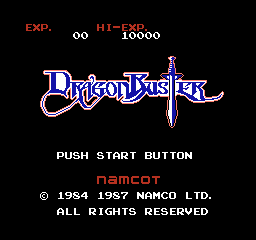Dragon Buster (NES)
| Dragon Buster |
|---|
|
Developer: Namco
|
It's Zelda but with more dragons and brown hair.
Not to mention more difficulty.
| This page is rather stubbly and could use some expansion. Are you a bad enough dude to rescue this article? |
Developer Credits
There is a copyright string inside the ROM, also with string "D.BUSTER", which used to see if the game performed a hard or a soft reset:
HARUHISA.UDAGAWA & KUMI.HANAOKA
CRC Test
There are a series of the Namco games, made by the same programmers Haruhisa Udagawa and Kumi Hanaoka, that contains the same self-test for the data integrity (Babel no Tou, Family Jockey, Lupin Sansei: Pandora no Isan, Mappy-Land, Pro Yakyuu: Family Stadium, Sanma no Meitantei, Sky Kid, Super Xevious: Gump no Nazo, Valkyrie no Bouken: Toki no Kagi Densetsu).
To enable any of these tests, you need a special device that should be plugged into the expansion port. The operation of that device is very simple. It should accept the data bit from the data input port and return it back inverted to the output data port. The device consists of a 4-bit shift register, working as some sort of FIFO buffer. The input bits goes to the input and then shifted to be output after 4 cycles.
At the game's boot, it tries to send some special data to the device. If the data output doesn't match the data input inverted, then the game continues the normal operation. But if all data (usually 32, rarely 64 bytes) matches, self-tests will be performed. The program calculates 24-bit partial checksums for the PRG (excluding the last 8K) and the CHR data, summing only every 15th byte, and comparing it against the etalon.
Before testing of the PRG data, the background color turns red, before testing the CHR data, it turns green. If any of these tests are failed, the program will jump directly to the reset routine. It means, one of these tests will be performed infinitely, but until the special device is unplugged, or until the tests are passed.
Normally, you'll see the red to green flash just before the game's boot. Or the static red screen if the PRG data is bad, or the flashing red to green screen if CHR data isn't good.
Using this Game Genie code GAUYNTEI, you can skip tests for the special device presence and jump straight to the integrity tests.
Cleanup > Pages missing date references
Cleanup > Pages missing developer references
Cleanup > Pages missing publisher references
Cleanup > Stubs
Games > Games by content > Games with debugging functions
Games > Games by content > Games with hidden developer credits
Games > Games by developer > Games developed by Bandai Namco > Games developed by Namco
Games > Games by platform
Games > Games by publisher > Games published by Bandai Namco > Games published by Namco
Games > Games by release date > Games released in 1987
Games > Games by release date > Games released in January
Games > Games by release date > Games released in January > Games released on January 7
The Cutting Room Floor > Unimportant Awards > NES games
